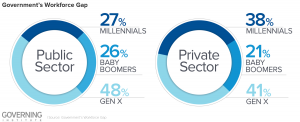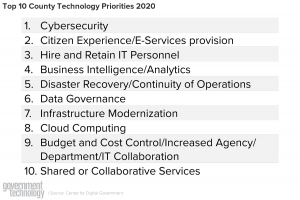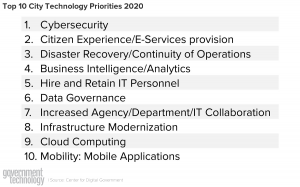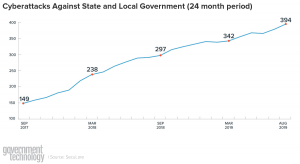The Silver Tsunami & Recruiting the Next Generation

Times are changing! Gone are the days of dial up and manual processes; we are in the age of automation, saturated with digital streaming, apps for everything, cars that park themselves and technology integrated into schools’ core curriculum.

Technology is changing so rapidly that the skills of technology professionals become outdated faster than ever before. According to a recent article published by GovTech, this ever-changing tech landscape, coupled with the nearly 30 percent of staff that will retire in the next five years and the inability to recruit replacements, places government at a disadvantage. This alarming retirement rate has been coined the The Silver Tsunami. According to the Bureau of Labor Statistics, by 2022 more than 25 percent of U.S. workers will be 55 years old or older. And according to NPR, nearly 10,000 baby boomers reach retirement age every day.
Though this is an epidemic affecting the entire workforce, government is keenly affected by this change. Why? Historically, government has been perceived as a sector lacking in innovation, bountiful in inefficiencies and not on the cutting-edge of culture trends. This poses a threat when recruiting the workforce for the next generation. The public sector is fighting for next generation’s recruits while private sector businesses are touting new-age technologies like artificial intelligence and blockchain.
According to the Center for Digital Government (CDG), recruitment and retention is a top priority right alongside cybersecurity.


So, how can your jurisdiction prepare for the inevitable generational shift when their workers retire, and the recruitment of Gen-Z is in full force? Is your software modern enough to match the tech skills of the iPhone generation? Technology is evolving rapidly and cyberattacks are becoming more prevalent with each passing day – it’s time for your jurisdiction to catch up with the times.
How exactly will the Silver Tsunami affect your jurisdiction?
More than 80 percent of organizations say they lose experience, business knowledge and leadership when an older worker retires. This rings even truer for the jurisdiction still running on a 1980s AS/400. How many 25-year-olds do you know that know what an AS/400 is, much less how to operate one?
More than likely, the employees who procured, implemented and passed down your jurisdiction’s current software and processes are on the way out the door to spend their days golfing and being a full-time grandpa/grandma. In fact, in a recent survey, 36 percent of respondents reported their software was 5-10 years old, 30 percent reported 10-15 years old and 14 percent reported that their software is more than 15 years old! To put that in perspective, there are jurisdictions in 2020 running on software that was created in the same year (2004) the Motorola RAZR cell phone was considered cutting edge technology. As this scenario proves, a once modern and cutting-edge product, workflow, process or software, years later, is now old hat.
So how can you, as a jurisdiction, reinstate the good name of government?
It all begins with perception. Today’s government is not your parent’s government any longer. Many local governments across the U.S. are embarking on innovative initiatives and embracing new trends and technologies. Organizations like The Center for Digital Government (CDG) annually recognize states, cities, counties and towns using technology to tackle social challenges, enhance services, strengthen cybersecurity and more. Among the cities listed are San Diego, Calif., Miami, Fla., Norfolk, Va., and Weston, Fla. These jurisdictions “are working to make their communities more secure, user-friendly, efficient and resilient,” said Teri Takai, executive director for CDG. “Their efforts are making technology a driver of better, smarter, more responsive government.”
The purpose of government is to provide, serve and help people; this aligns perfectly with the younger generation’s desire to make a difference. Jurisdictions already have the power to recruit and engage the younger generations–they just need a push in the right direction (innovation and modernization) to get the ball rolling.
Now is the time to modernize your internal processes starting with a modern approach to your financial and community development software – the core of your everyday operations. Utilizing a software designed in an era where fax machines were still prevalent affects you more than you know.
5 Aging Software Effects:
Iffy Cybersecurity – Creators of legacy software were not thinking forward to the cybersecurity concerns of the 21st century. Cybersecurity issues are a global problem and not merely local problems. Even for the smallest and most remote of government jurisdictions, you cannot afford to wait one more minute to take the most proactive and aggressive steps possible to protect your jurisdiction’s data. Ransomware attacks and phishing were not prevalent threats to local government until recent years, and since their debut, attacks are only becoming more and more common.  In 2019 alone, there were a reported 140 ransomware attacks on local governments and other public sector organizations. So, why attack local governments?
In 2019 alone, there were a reported 140 ransomware attacks on local governments and other public sector organizations. So, why attack local governments?
“Some say these organizations were ill-prepared to defend themselves. The bad guys saw this as “low-hanging fruit” when compared to attacking large banks, or taking on the U.S. Department of Defense (DoD) or some three-letter agency in Washington, D.C.,” said Dan Lohrmann, Chief Security Officer & Chief Strategist at Security Mentor Inc.
High IT costs – Legacy on-premise software tend to bleed IT budgets dry with costly maintenance and upgrades unlike true-cloud software solutions.
Upgrade Dysphoria – The older the software, the more technologically irrelevant it becomes every day. You have to constantly deal with costly and disruptive upgrades with legacy software. Are you on version 19.8.4, while another department manager is on version 18.9.10? With a modern, true-cloud solution, everybody using the software is using the same, latest version, and product upgrades are fast, regular and at no additional cost.
Disengaged Employees – Remember when talked about that big generational shift on the horizon? Modern, top-talent employees are incredibly tech-savvy and expect tools with modern tech. They have little patience for outdated software issues like manual processes and lack of 24/7 access across all devices. To attract tomorrow’s talent, it is imperative your software is fast, easy and powerful.
Decentralized Information – Outdated systems cannot provide your citizens nor your workforce with the centralized information they need at any time, from anywhere and on any device. Historically, getting a cohesive report is an entire ordeal of contacting IT and navigating numerous platforms to try to discern which numbers are correct and current. Modern technology can easily provide you with a 360º view of your jurisdiction and produce accurate, instant and intelligent reports.
To mitigate the risks of the Silver Tsunami and Millennial and Gen-Z influx, it is imperative your software adapts with your changing workforce. You need a secure and flexible software solution to accommodate your jurisdiction’s unique needs. That’s where cloud technology comes into play. True-cloud software enables governments to manage IT costs, optimize efficiency by eliminating manual paper processes, streamline processes and improve productivity.
GovSense is the first complete cloud solution purpose-built for local governments, empowering over 60 communities and supporting more than 2 million citizens. Govsense built on Oracle NetSuite—the #1 true cloud ERP platform with over 50,000 customers worldwide— GovSense delivers a modern, unified system that streamlines operations, enhances transparency, and drives efficiency. GovSense’s team has been implementing cloud solutions since 2005, bringing over two decades of expertise in delivering scalable and secure technology for local agencies. As a five-time GovTech 100 recipient, we are recognized as an industry leader in transforming government technology. GovSense is one modern platform that has everything you need for your local government, ensuring your community is equipped with the tools to thrive in the digital age.
